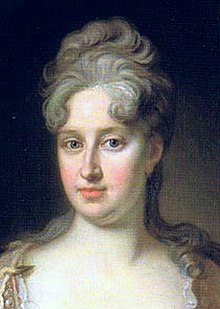Sophie Luise of Mecklenburg-Schwerin
Sophie Luise, Duchess of Mecklenburg [-Schwerin] (born May 6 . Jul / 16th May 1685 greg. In Grabow , † 29. July 1735 in Schwerin ) was through her marriage to Frederick I , the second queen in Prussia .
Life
origin
Sophie Luise, sometimes incorrectly referred to as Princess / Duchess of Mecklenburg-Grabow after her place of birth , was the fourth child and the only daughter of Duke Friedrich zu Mecklenburg [-Schwerin] (called "Prince von Grabow" ) and Landgravine Christine Wilhelmine of Hesse -Homburg (1653-1722). After the early death of her father, the princess grew up at the court of her eldest brother Friedrich Wilhelm , who ruled in Schwerin as Duke of Mecklenburg. Apart from French and music lessons, she received no special training. On the other hand, her reserved and serious nature corresponded to a strict Lutheran upbringing.
Prussian queen
After 1705 his second wife, Sophie Charlotte , had died, the now fifty years old king was Frederick I in Prussia by the court party to the influential Prime Minister Graf von Wartenberg pressed to remarry. Dynastic reasons for securing the succession to the throne moved the ailing monarch not to close himself off. His only son Friedrich Wilhelm had not yet had an heir to the throne for the kingdom. A new wife for the aging king increased the chances of finally changing this situation.
After a long search, the right candidate for the king's marriage was found in the 23-year-old Princess Sophie Luise, who is known as the “Mecklenburg Venus”. On November 28, 1708, the wedding was celebrated in the Berlin Palace . As the third wife of Frederick I, however, the young queen always remained in the shadow of her predecessor, the intellectual Queen Sophie Charlotte, who had socialized and glamorous court with famous scholars. The real purpose of the marriage, to give the country an heir, remained unfulfilled. The marriage remained childless. Sophie Luise was soon followed by a court life filled with intrigue, hatred and slander, which the young queen was neither mentally nor physically up to. Especially her opponent Katharina Countess Kolbe von Wartenberg , b. Rickers, the wife of the de facto prime minister, made her life difficult.
With resignation, Queen Sophie Luise withdrew to her role as the loyal nurse of her husband, whom she tried to convert from the Reformed creed to Lutheranism under the influence of her bigoted lady-in-waiting, Miss von Graevenitz . At first, Friedrich also let her take part in the representation tasks; she was allowed to accompany him everywhere and in the evenings to stop him at the Tobacco College , which he had founded as the first king in Prussia. Over time, however, under the influence of the teachings of August Hermann Francke, her religious zeal turned into an obsessive pietism .
The queen fell into deep depression and mental confusion, so that she could no longer take part in court life. Unbearable arguments between the married couple about the “true” creed and increasingly frequent attacks caused the king to separate from his insane wife. Completely confused and covered in blood from a cut, she is said to have frightened the sick king in the Berlin Palace, who at first thought he was seeing the legendary " white woman " as the messenger of death, who according to legend usually appears shortly before the death of a family member.
Last years of life
In January 1713, Queen Sophie Luise was brought to Perwenitz in the Havelland by her husband just a few weeks before his death . His successor, King Friedrich Wilhelm I , sent the sick woman back to her family in Mecklenburg . There she lived first at the castle in Grabow , then for a short time in Neustadt-Glewe and later in Schwerin Castle , where she died in 1735 at the age of fifty. Sophie Luise found her final resting place in the Schelfkirche St. Nikolai in Schwerin.
Afterlife
In Berlin, the Sophienkirche in the Mitte district , which she founded in 1712 as namesake, still commemorates the unhappy third wife of the first Prussian king.
Friedrich Griese made Sophie Luise the title heroine of his novella The Princess von Grabow. A report from the eighteenth century. (Schünemann, Bremen 1936).
literature
- Friedrich Wigger : From the life of Queen Sophie Louise of Prussia (the "Princesse von Grabow"). In: Yearbooks of the Association for Mecklenburg History and Archeology, Vol. 41 (1876), pp. 3–97, 158 ( digital copies )
- Christine von Brühl : Grace in the Brandenburg sand. The women of the Hohenzollern . Structure, Berlin 2015, ISBN 978-3-351-03597-6 , p. 128-144 .
- Karin Feuerstein-Praßer: The Prussian queens . Piper, Munich / Zurich 2008, ISBN 978-3-492-25295-9 , pp. 104-117 .
Individual evidence
- ↑ At the time of her birth, the Julian calendar was still in effect in Mecklenburg. For the date of birth cf. also Friedrich Wigger (1876), p. 10 f.
Web links
- Literature about Sophie Luise in the state bibliography MV
- Biography of Queen Sophie Luise (on preussen.de)
- Biography of Queen Sophie Luise (Prussian Palaces and Gardens Foundation)
- Tripota - Trier portrait database
| predecessor | Office | Successor |
|---|---|---|
| Sophie Charlotte |
Queen of Prussia 1706 to 1713 |
Sophie Dorothea |
| personal data | |
|---|---|
| SURNAME | Sophie Luise |
| ALTERNATIVE NAMES | Sophie Luise von Mecklenburg-Schwerin (wrong name form); Sophia Luisa von Mecklenburg-Grabow (wrong name form) |
| BRIEF DESCRIPTION | Princess of Mecklenburg-Schwerin; Duchess of Mecklenburg, Prussian Queen (1708–1713) |
| DATE OF BIRTH | May 16, 1685 |
| PLACE OF BIRTH | Grabow (Elde) |
| DATE OF DEATH | July 29, 1735 |
| Place of death | Schwerin |

